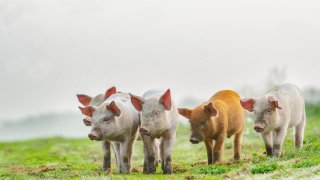
- The Danish research is the latest example of how organizations and businesses are attempting to integrate new ideas and innovations into the farming sector.
- The sensor technology is able to carry out continuous monitoring of gases such as ammonia.
A team in Denmark has developed a sensor-based system which could help to tackle air pollution by detecting ammonia and other gases emanating from the agriculture sector.
Alongside chemical engineers and chemists, researchers from Aarhus University and the Technical University of Denmark worked on the technology as part of the Ecometa project, which is focused on cutting emissions connected to agriculture.
The researchers at the universities are focused on photonics, a term the European Commission has described as "the science and technology of light." Details of their system have been published in the journal "MDPI Photonics."
According to an announcement earlier this week, those involved in the project have produced an integrated optical sensor which "measures ammonia in the air using a laser, a gas sensor and hollow-core optical fibres."
Andreas Hansel is a postdoctoral researcher at Aarhus University's Department of Engineering. In a statement issued Tuesday, he explained the system was able to demonstrate how it was possible to "carry out continuous ammonia monitoring for the agricultural sector."
Due to the fact it was based on "mature telecommunications technology," Hansel added the system could be put together "at very low cost."
Agriculture and ammonia
Money Report
There's an intimate relationship between the rearing of livestock, the waste these animals produce and air pollution.
"Manure emits ammonia, which combines with other air pollutants, like nitrogen oxides and sulfates, to create tiny (and deadly) solid particles," the Natural Resources Defense Council (NRDC) states. Humans, the NRDC adds, inhale these particles, which can in turn damage health.
To be sure, air pollution is a global public health crisis. It kills an estimated 7 million people worldwide every year, according to the World Health Organization, with nine out of 10 people thought to be breathing air containing high levels of pollutants.
Back in Denmark, Tuesday's announcement from Aarhus University described livestock production as being "responsible for a significant part of Danish air pollution, primarily from ammonia."
The issue, according to those involved in the project, is that ammonia emissions are not currently measured at "farm level" due to concerns over cost.
It's hoped the low-cost system being developed by the researchers could help to change the way emissions are monitored.
"The new technology takes us one step closer to enabling farmers to monitor their emissions continuously," said Anders Feilberg, an associate professor at Aarhus University involved with the Ecometa project.
"With accurate monitoring of ammonia emissions from sheds and stables, farmers can streamline operations far better," Feilberg added.
"This takes us closer to emissions-based regulation using measured emissions, and it can significantly reduce the environmental impact of agriculture."
Tech's role in farming
The work being undertaken in Denmark is the latest example of how organizations and businesses are attempting to integrate new ideas and innovations into the farming sector.
At the end of March 2019, for example, fruit grower T&G Global announced that a robotic harvester was being used to carry out a commercial apple harvest in New Zealand. The automated apple-picking robot was developed by Abundant Robotics, a California-based technology firm.
Last year also saw engineers at the University of Cambridge develop a robot that utilizes machine learning to pick lettuce.
More recently, tech giant Alphabet's so-called "moonshot factory" — also known as X — shared details about a project aiming to change agriculture and food production through the use of technologies including robotics, software and satellite imagery.






